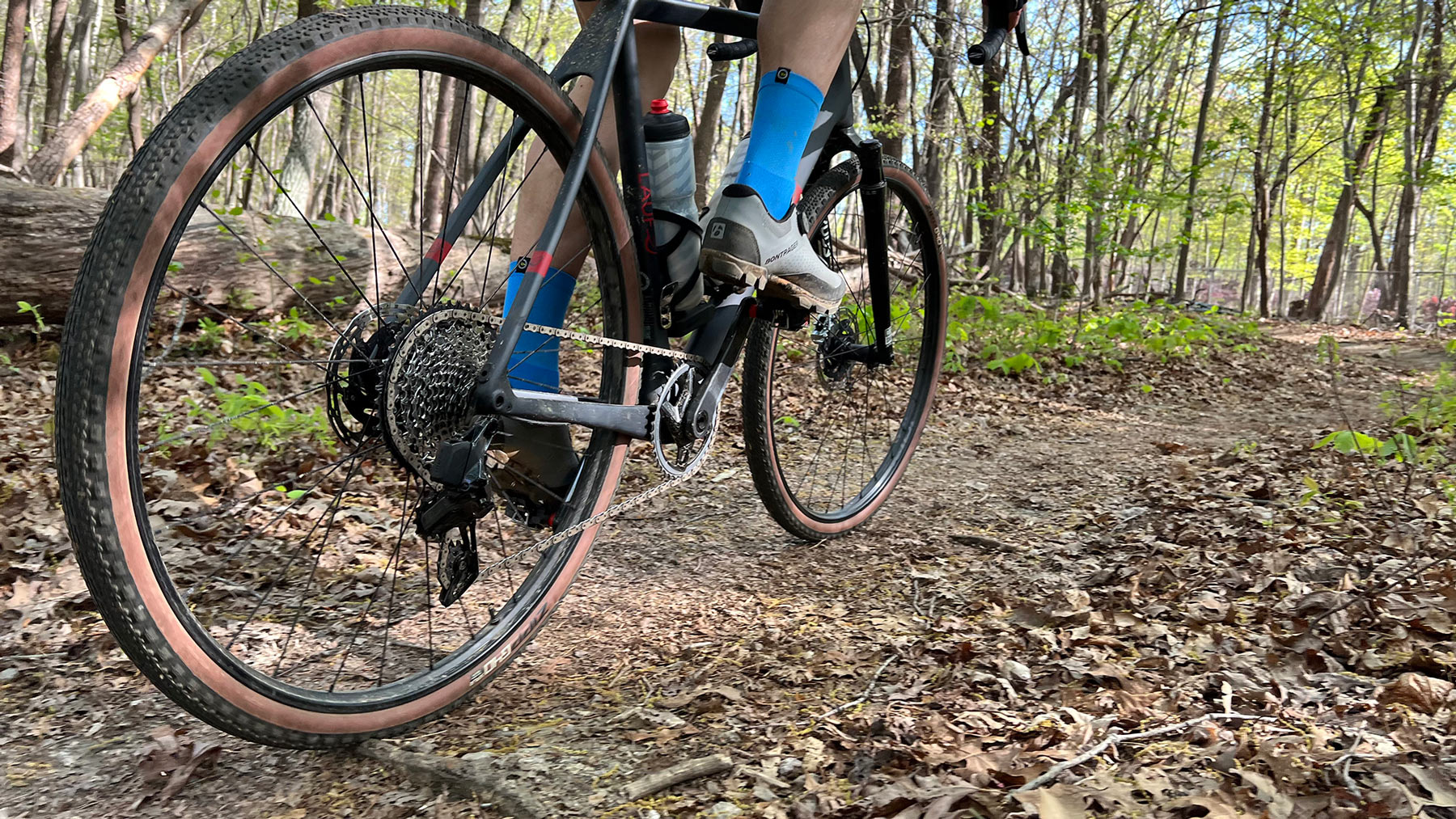If we’re being honest, SRAM’s foray into gravel bike drivetrains has been a bit confusing. Starting with a hydraulic “clutch” on all of their eTap AXS road bike derailleurs, introducing “Force Wide” to accommodate gravel’s larger tires, and an assortment of derailleurs that almost required a diagram to find compatible cassettes, it was enough to make you look away.
Then, finally, they introduced a complete XPLR group that includes Zipp wheels and a Rockshox Rudy fork. If the product has XPLR on it, it works together. Which, when it comes to drivetrains, only really refers to the rear derailleur and 10-44 cassette. It’s only compatible with 1x drivetrains, but you can use any crankset and 12-speed 1x chainring.
So, while everything can still be mixed and matched, running an Eagle 12-speed mountain bike derailleur and cassette, paddle or drop bar shifters, etc., the XPLR “group” optimizes cage length and gear ratios and gear steps for the vast majority of gravel situations.
And now that I type that out, perhaps it doesn’t really simplify it, but it follows in SRAM’s apparent logic of “let’s optimize each component for a specific, relatively narrow gear range so that it performs as crisply as possible.” And with that in mind, here’s my review…
SRAM XPLR drivetrain review
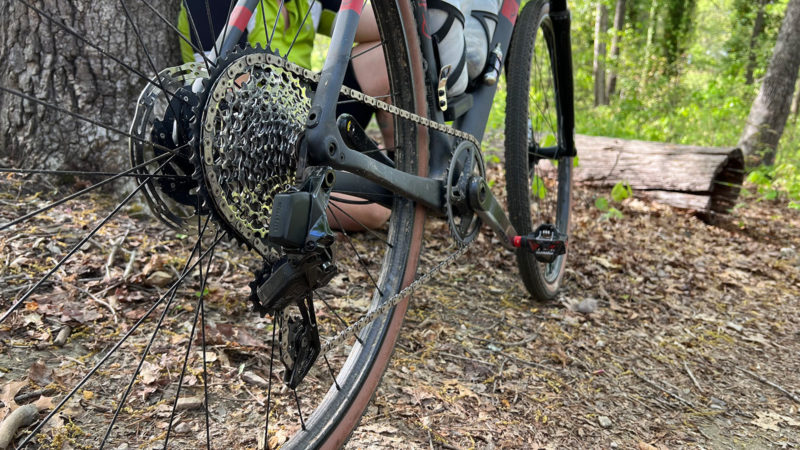
The SRAM XPLR groups offer two cassettes, the top-level 1271 with alloy backing plate shown here, and a 1251 with fully pinned construction. Both are 10-44 and use their XDR freehub body.
The range really is the sweet spot for gravel. From flat to rolling hills, it offers the right spread, with the ability to easily swap their direct-mount chainrings from 38 up to 46 teeth to accommodate the course du jour. If you’re routinely riding big mountains and need more range, just go for the Eagle AXS setup with a 10-50 instead.
For comparison, the Shimano GRX groups (for now) are designed to work with 11-speed road and mountain bike cassettes, with the latter using MTB derailleurs rather than the GRX derailleur, same as SRAM does. The Campagnolo Ekar 13-speed group has 9-36, 9-42, and 10-44, which all add an additional cog for smoother gear steps at the small end of the cassette, but the same gear range on the largest cassette.
So, even though SRAM XPLR has a single cassette, the reality is you can mix and match across parts for almost every brand, or for Campy, choose from a variety of cassettes and chainrings to get it where you need it. Apples to apples, just maybe Pink Lady to Red Delicious to Honeycrisp.
Oh, and the XPLR derailleurs are also compatible with SRAM’s 10-36 cassettes, too, but those aren’t branded XPLR.
Got it? Good.

The beauties of the SRAM system are the additional trim levels and the derailleur’s hydraulic Orbit damper that’s not a clutch.
XPLR derailleurs are offered in Rival ($269), Force ($369) and RED ($749). Combined with the two cassette options, there’s something for most budgets.
Like the road bike derailleurs, the Orbit is a fluid damper that simply slows the cage’s movement to prevent wild chain movement over harsh terrain. Unlike a spring-loaded clutch, it’s not adding tension to the system (although, like all derailleurs, the cage is still spring loaded to maintain appropriate chain tension).
So, technically, it’s not fighting the motor (because all trim levels are AXS, no mechanical options offered), but it is ridiculously good at taming chain slap.
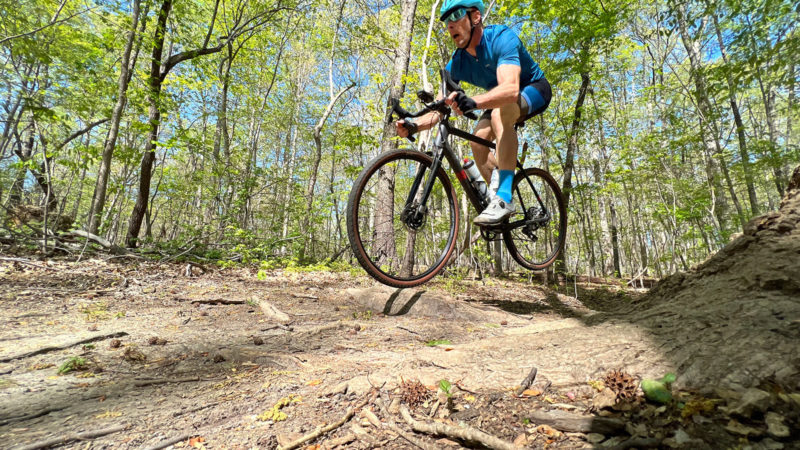
No matter if it’s root gardens, chunky gravel, drops, or big bunny hops, the chain stays quiet and on track.

The group is also really good at executing shifts under power, even when riding through rough stuff. Smooth delivery, easy shifts, and reliable performance are the highlights.
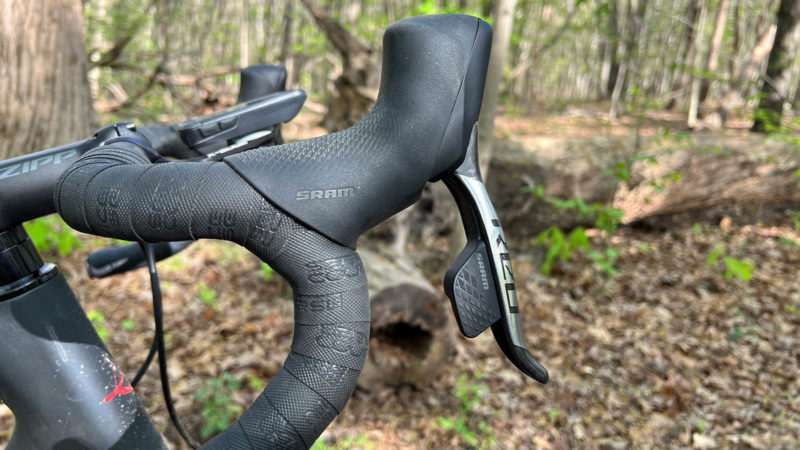
The larger, textured shift paddles make things easy, even with full finger and winter gloves, and braking ergonomics are pretty good.
Out of the box, the levers are very far forward, so I recommend taking the time to adjust the reach for maximum safety and the best ergonomics. Once I had it dialed in, one-finger braking is enough for casual stopping, and getting two fingers into position is easy enough and provides more than enough leverage for most situations.
I still prefer getting in the drops on fast, aggressive, and steep descents, and having the levers in easy reach (see above recommendation) is key here, too. Fortunately, SRAM’s drop bar levers have plenty of adjustment range.
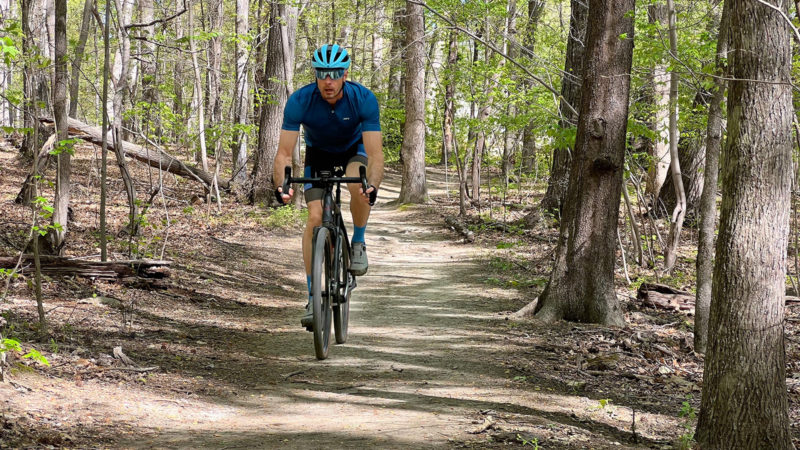
Overall, XPLR is a reliable, well-performing group with a cornucopia of options to fit any style of bike or riding.
Rockshox Rudy XPLR & Reverb AXS review
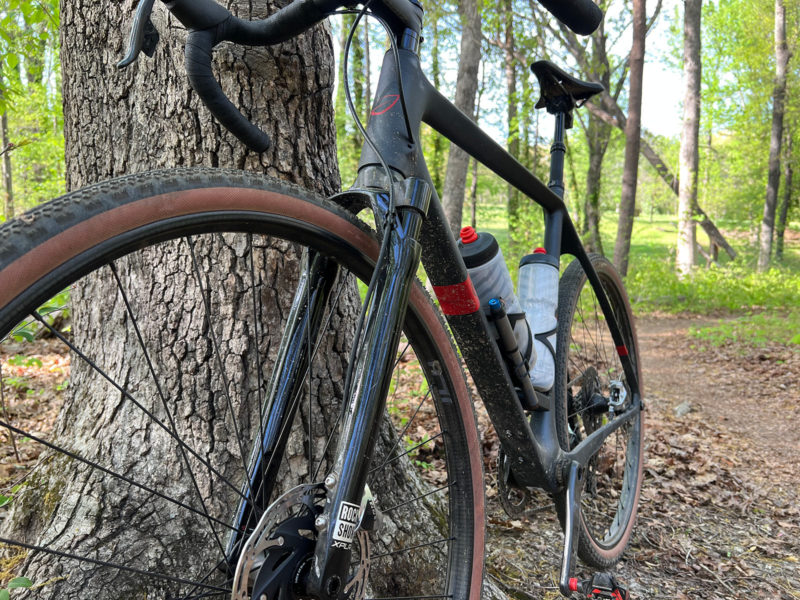
With almost every suspension brand offering a gravel fork now, the Rockshox Rudy XPLR (particularly in the gloss black) has the sleekest looks. It looks slim and petite by comparison, with curves and lines at the dropouts and arch that help it disappear on the bike. This is a good thing.
My testing thus far has been on the 30mm travel version, which helps highlight the Zipp wheels (keep reading), but in all honestly, just get the 40mm travel version. Unless you absolutely need to keep the lowest possible front end, there’s no reason not to have a bit more travel.
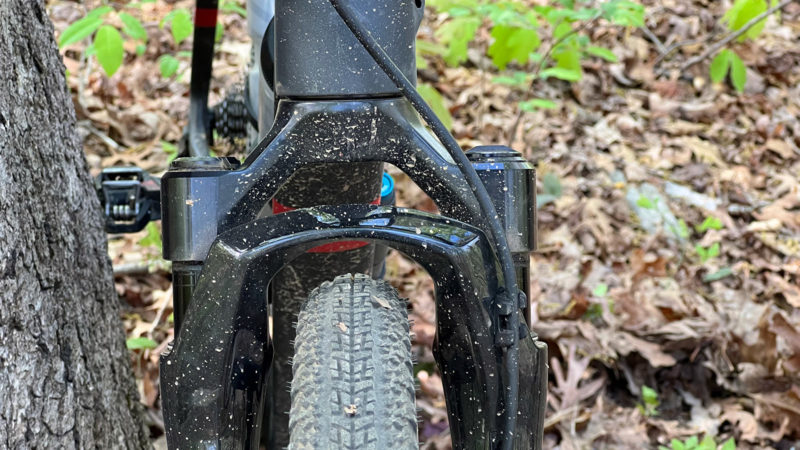
Clearance for 700x50mm tires provides all the room anyone would need before just using a mountain bike. Tool-free cable management looks clean and means no stress over losing a part or stripping out a tiny screw.

Controls are simple, just turn the knob to adjust the Race Day damper’s compression damping from open to closed. Full range rebound adjustment is on the bottom with a removable knob.

Fender mounts behind the arch work with a custom Rockshox fender, but there are also hidden mounts underneath the dropout for attaching a full coverage fender from other brands.
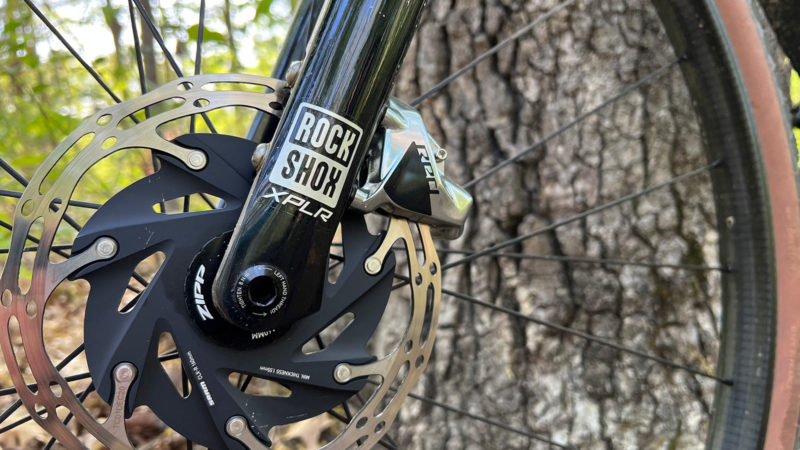
Flat mount brakes come from their road bikes, no XPLR specific brakesets are offered. The Rudy places the calipers in position for 160mm rotors with no adapters; they’re compatible with 180mm rotors with an adapter.
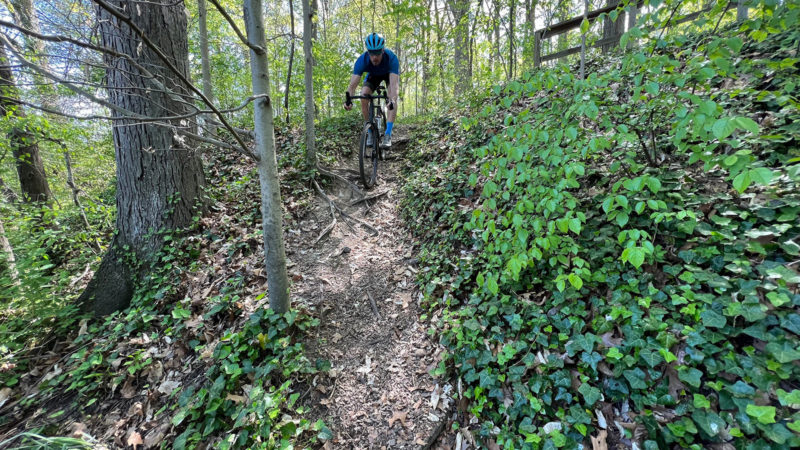
Riding the Rudy felt controlled, and its 30mm travel worked well with the Zipp Moto wheel’s ability to mold to the terrain (keep reading). The best word I could think of is “supportive” while still opening up the bike (and me) to more aggressive terrain.
I ride this drop-in a lot on all my gravel bikes, but the control provided with this setup let me go faster with more confidence. Instead of picking carefully around each root, I could just roll through them, focusing more on the exit.
With such a small amount of travel, I didn’t miss any extra compression damping controls and just left it open all the time. There’s minimal movement under spirited standing efforts because, well, there’s minimal travel, and Rockshox’s latest damper designs and air springs do a great job of providing mid-stroke support. And it all feels like “mid stroke” on such a short travel fork.
Rebound adjustments are adequate, and a nice feature. The air spring can be tuned with volume spacers, which is definitely worth fiddling with even here.
What about the Reverb AXS XPLR?
The Reverb AXS is probably the best thing to happen to dropper posts…for mountain bikes. The effortless activation is the best use for wireless, and it’s probably tripled my dropper usage.
For gravel, I like the idea of it better than the execution, for two reasons. First, it’s more cumbersome than it seems to press both left and right shift paddles simultaneously, which is how the XPLR model is actuated. It requires just enough fingers-off-the-brakes to make it feel uncomfortable at best and unsafe at worst.
I found myself having to either anticipate usage well in advance, or slow excessively before using it while on a descent. Traditional, mechanical dropper levers placed mid-bend on the handlebar feel more intuitive and comfortable for me in this use case, and that they can be used one-handed is even better. I feel like SRAM can solve this, and I hope they do, because the function of the Reverb itself is fantastic.
Second, though, the “suspension” feature is hard to use. It requires the post to be dropped into its travel, even as little as 1mm, in order to offer some cushioning. Seems brilliant, but getting it to drop just a couple millimeters such that it doesn’t alter your seated position too much is all but impossible during normal riding. Again, I feel like this is something SRAM can find a better solution for, hopefully with a firmware update, but as is, the feature is just really hard to use successfully.
ZIPP 101 XPLR gravel wheels review
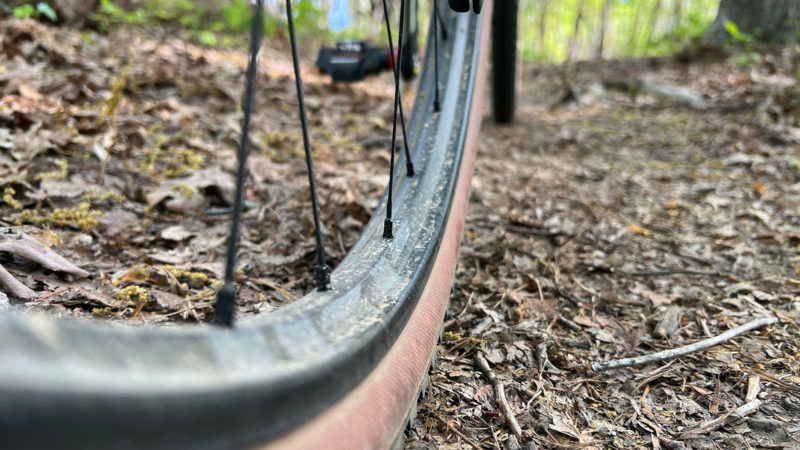
The Zipp 101 XPLR gravel wheels are a narrower version of their 3 Zero MOTO mountain bike wheels, which are amazing. They have the same ground-taming benefit, and the same weight detriment, making them a wheelset that’s devastatingly effective…with a fairly narrow use case.
Like the MTB wheels, they use a single-wall design with “ankle flex”, essentially letting them twist along the spoke bed’s plane to adapt to the ground underneath. The effect isn’t as dramatic as the MTB wheels because they aren’t as wide (so, less leverage from the ground), but it’s there.
Combined with the fork, there was a certain something about riding this bike that was hard to put a finger on, but it was just uncannily able to track the ground. Roots? Rocks? Crunchy corners? No problem. Traction, even with the fairly low-profile Zipp tires, was next level. It gave the bike a new personality that made the same old trails and roads more interesting, and let me push a bit harder.
The caveat is, they’re heavier than any other high-end gravel wheel, so I’d only pull these out for the right races. Think Grinduro, where it’s almost more mountain bike race than gravel. Gnarly terrain is where they shine, and where they’re worth the extra grams.
Final thoughts?
Any one of these parts, save (and I’m pained to say this) for the Reverb AXS XPLR, are great on their own. Put them all together (especially the Rudy and 101 Motos) and the sum is greater than the parts. The versatility of their drivetrain parts to be mixed and matched is greater than either of their competitors’ collections, even if they do sometimes take a little extra research to sort out.
I’ve been riding all of these on and off (I have a lot of bikes) for a bit over a year, in wet, dry, cold, and hot conditions and they’ve held up admirably. Generally I’ve had no undue durability issues with any of the SRAM stuff I’ve tested and suspect these will continue to ride strong for years to come.
